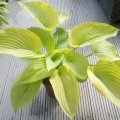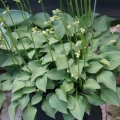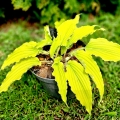Online Shop
128
Royal Horticultural Society
Gold Medals
Royal Horticultural Society
Gold Medals
- Home
- About Ferns
- Tree Fern Care
Tree Fern Care
Tree ferns grow under the forest canopy in partially shaded areas and
are best suited to a sheltered, moist environment. They like protection
from drying winds and mid day sun (although if well watered most can
tolerate sunny situations). In the wild they are often found thriving in
areas where few other plants survive.
Ferns are considered to be 'top feeders' as the plant growth area occupies approx. 30-60cm below the crown or top of the plant. The remainder of the trunk is made up of the root system and old frond bases. In its natural environment the crown is often found to be full of decaying leaf matter that has fallen from the canopy above. This helps retain moisture, protects the crown in winter from the cold and provides nutrient as the leaf matter decomposes. A large amount of moisture and nutrient exchange is through the crown, so it would be serious neglect not to water and feed ferns from the top.
On arrival, your tree fern should be anchored vertically and thoroughly soaked (remember to water the crown of the plant). At first water every day until the fronds start to emerge. At this point the use of Tree Fern Feed will help to encourage vigorous foliage and root growth. So during the growing season as the fronds start to move, feed weekly into the crown of your tree fern. Also be sure to water regularly during the Spring and Summer to ensure the crown of your tree fern is always kept moist.
The tree fern is an evergreen plant, although in many areas of Europe it is likely that in Winter frost will 'burn off' the existing fronds and potentially damage the following season's growth. Hence, unless your ferns are in a frost-free environment, protection from frost is advised. The best solution is to place straw into the crown thus protecting the new growth for next season. Also cover the top part of the trunk below the crown with more straw, held in place by hessian sacking or wire mesh. All this can be removed in Spring just before the new season's fronds begin to grow (after the last frost has gone). Young plants should be kept in a frost-free environment.
Finally, each fern is different and each situation may be different. The fern may be placed in a small stone courtyard in central London, a small garden in the country or in managed gardens open to the public. In each instance it is advisable to consider the local climate and, most importantly, the micro-climate surrounding the plant. It is therefore vital to get specific advice for the fern variety, its suitability for the intended purpose and how best to care for it. We strongly advise that consultation is sought with an experienced local specialist who is able to give advice on how best to care for ferns in your area.
Things to remember are:
• Water regularly from the top ensuring the crown does not dry out
• Feed from the top: the life of the plant is at the top of the trunk
• Grow in a sheltered area protected from drying winds and midday sun
• Needs moisture, damp conditions and well-drained soil near water
• Protect from frost: remove protection after last frost
• No need for pesticides: generally pest and disease-free
Ferns are considered to be 'top feeders' as the plant growth area occupies approx. 30-60cm below the crown or top of the plant. The remainder of the trunk is made up of the root system and old frond bases. In its natural environment the crown is often found to be full of decaying leaf matter that has fallen from the canopy above. This helps retain moisture, protects the crown in winter from the cold and provides nutrient as the leaf matter decomposes. A large amount of moisture and nutrient exchange is through the crown, so it would be serious neglect not to water and feed ferns from the top.
On arrival, your tree fern should be anchored vertically and thoroughly soaked (remember to water the crown of the plant). At first water every day until the fronds start to emerge. At this point the use of Tree Fern Feed will help to encourage vigorous foliage and root growth. So during the growing season as the fronds start to move, feed weekly into the crown of your tree fern. Also be sure to water regularly during the Spring and Summer to ensure the crown of your tree fern is always kept moist.
The tree fern is an evergreen plant, although in many areas of Europe it is likely that in Winter frost will 'burn off' the existing fronds and potentially damage the following season's growth. Hence, unless your ferns are in a frost-free environment, protection from frost is advised. The best solution is to place straw into the crown thus protecting the new growth for next season. Also cover the top part of the trunk below the crown with more straw, held in place by hessian sacking or wire mesh. All this can be removed in Spring just before the new season's fronds begin to grow (after the last frost has gone). Young plants should be kept in a frost-free environment.
Finally, each fern is different and each situation may be different. The fern may be placed in a small stone courtyard in central London, a small garden in the country or in managed gardens open to the public. In each instance it is advisable to consider the local climate and, most importantly, the micro-climate surrounding the plant. It is therefore vital to get specific advice for the fern variety, its suitability for the intended purpose and how best to care for it. We strongly advise that consultation is sought with an experienced local specialist who is able to give advice on how best to care for ferns in your area.
Things to remember are:
• Water regularly from the top ensuring the crown does not dry out
• Feed from the top: the life of the plant is at the top of the trunk
• Grow in a sheltered area protected from drying winds and midday sun
• Needs moisture, damp conditions and well-drained soil near water
• Protect from frost: remove protection after last frost
• No need for pesticides: generally pest and disease-free
New Additions
-
Bowdens 2024 Catalogue £0.00

-
Wundergold £15.00

-
venusta 'Porter' £8.00

-
Valley's Love Birds £14.00

-
Valley's Lemon Squash £14.00





